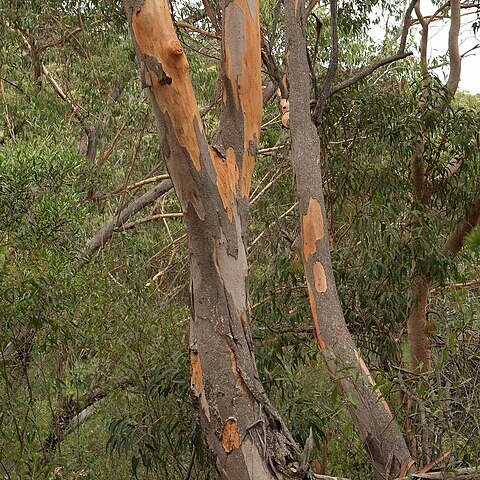Tree to 35 m. Bark grey gum type. Juvenile leaves narrowly lanceolate to lanceolate. Adult leaves lanceolate, slightly falcate; lamina 8–15 cm long, 1.6–3 cm wide, shining above; lateral veins just visible, at 45°–55°; intramarginal vein up to 1 mm from margin; petiole channelled or flattened, 15–26 mm long. Umbels 7-flowered; peduncle flattened or angular, 5–20 mm long; pedicels angular, 2–9 mm long. Buds ovoid to cylindrical; operculum conical, hemispherical or slightly rostrate, 5–6 mm long, 4–6 mm wide; hypanthium obconical or hemispherical, 4–5 mm long, 4–6 mm wide. Fruits hemispherical or cylindrical, 5–12 mm long, 5–10 mm wide; disc moderately broad, level or ascending; valves 3 or 4, exserted. Seeds black.
Tree to 35 m with cream to orange, later grey or grey-brown usually smooth matt bark.. Juvenile leaves lanceolate; adult discolorous, lanceolate, slightly falcate, 8–15 cm long, 1.6–3[3.5] cm wide, shining above; petiole channelled or flattened, 1.5–2.6 mm long.. Umbels 7-flowered; peduncle flattened or angular, 0.5–2 cm long; pedicels angular, 2–9[10] mm long.. Buds ovoid to ± cylindrical; operculum conical or hemispherical or slightly rostrate, 5–6 mm long, 4–6 mm wide.. Calyx-tube obconical or hemispherical, 4–5 mm long, 4–6 mm wide.. Fruits hemispherical or cylindrical, 5–12 mm long, 5–10 mm wide with moderately broad level or ascending disc and 3–4 exserted valves.. Fig. 9/32, p. 45.
Tree to 30 m. Bark grey gum type. Juvenile leaves broadly lanceolate. Adult leaves lanceolate; lamina 8–12 cm long, 1.8–2.4 cm wide, discolorous; lateral veins just visible, at 45°–60°; intramarginal vein up to 1 mm from margin; petiole channelled, 15–25 mm long. Umbels 7-flowered, peduncle flattened, 10–20 mm long; pedicels thick, 4–6 mm long. Buds ovoid or clavate; operculum conical or hemispherical, angular, 5–7 mm long, 6–8 mm wide; hypanthium hemispherical, 4–6 mm long, 6–8 mm wide. Fruits hemispherical, 7–9 mm long, 6–9 mm wide; disc broad, level, convex or ascending; valves 3 or 4, exserted. Seeds black.
A medium sized tree. It grows 30 m high. The trunk is straight. The bark is smooth. It has a fairly dense crown of shiny dark green leaves. These are 15 cm long. The flowers are small and white.


